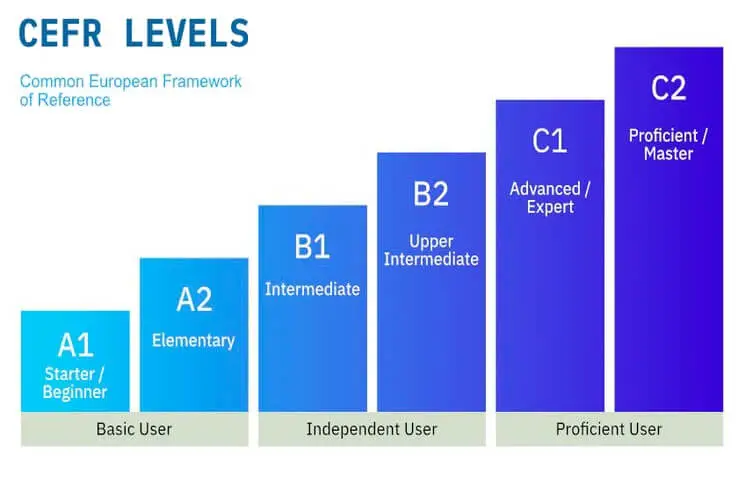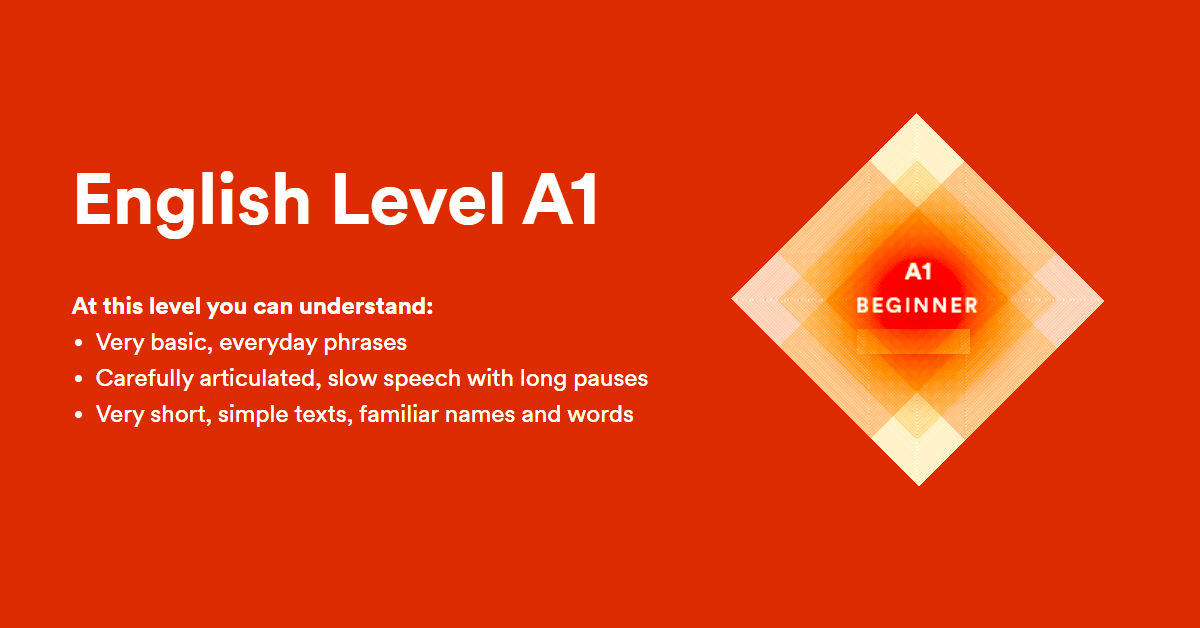A1 English Level (Beginner)
At this level you can understand:
- Simple, everyday expressions
- Slowly spoken with clear enunciation and long pauses
- Brief, straightforward texts with familiar names and vocabulary
-

English Level A1
The Common European Framework of Reference (CEFR), a list of various language proficiency levels created by the Council of Europe, classifies beginner English as level A1. This level is commonly referred to as “beginning,” and the CEFR uses that term as its official level descriptor. In real life, it is feasible to speak English at a level below A1. A1 students are those who are just starting their English studies or who have no prior knowledge of the language.


What is A1 Level English?
Level A1 is the lowest level of generative language use – the point at which the learner can interact in a simple way, ask and answer simple questions about themselves, where they live, people they know, and things they have, initiate and respond to simple statements in areas of immediate need or on very familiar topics, rather than relying purely on a very finite rehearsed, lexically-organised repertoire of situation-specific phrases.
Students at this level can understand and use familiar everyday expressions and very basic phrases aimed at the satisfaction of needs of a concrete type. They can introduce themselves and others and can ask and answer questions about personal details such as where they live, people they know and things they have. They can interact in a simple way provided the other person talks slowly and clearly and is prepared to help.
A1 Listening
Students are able to understand simple, standard speech which is very slow and is carefully articulated and can recognise familiar words and very basic phrases concerning themselves, their family and immediate concrete surroundings when people speak slowly and clearly.
A1 Reading
Students can understand very short, simple texts, for example on notices and posters or in catalogues, picking up familiar names and basic phrases one at a time and rereading as required.
A2 Speaking
They can interact in a simple way provided the other person is prepared to repeat or rephrase things at a slower rate of speech and help with formulation. They can ask and answer simple questions in areas of immediate need or on very familiar topics.
Students at this level can use simple phrases and sentences to describe what they do, where they live and people they know.
A2 Writing
At this level, students can write a short, simple message or postcard, for example sending holiday greetings. They can fill in forms with personal details, for example entering name, nationality and address on a hotel registration form.
What are the A1 Level Skills?
At this level, as defined by the Common European Framework of Reference for Languages, students progress in language skills to develop what are considered “Basic User” skills with the ability to:
Understand and use common everyday expressions and simple sentences to satisfy immediate needs
Interact in an elementary way as long as the interlocutor speaks slowly and clearly and is willing to cooperate
Introduce yourself and others, ask for and give basic personal information about your address, your belongings, and people you know
What will I be able to do after completing English Language Level A1?
Level A1 (Access) is considered to be the lowest level of general language use, the point at which learners can interact in a simple way, can ask and answer questions about themselves, about where they live, about the people they know and the things they have, can make simple statements in areas of immediate need or on very everyday topics and can respond to such questions when they are put to them, rather than simply relying on a very limited, rehearsed and lexically organized repertoire of phrases used in specific situations.
Comprehension
Listening Comprehension
Recognize very basic, commonlyused words and expressions relating to themselves, their family and their immediate environment when spoken slowly and clearly
Reading Comprehension
Understand familiar words and names and very simple phrases, e.g., those found on signs, posters, and catalogs
Speaking
Oral Interaction
Participate in a simple conversation, as long as the other person is willing to repeat what they have said or say it in other words and at a slower speed, and help them formulate what they are trying to say and answer simple questions on topics of immediate need or very common issues
Oral Expression
Use simple expressions and phrases to describe the place where they live and the people they know
Writing
Written Expression
Write short, simple postcards, e.g., to send greetings. Know how to fill in forms with personal data, e.g. name, nationality and address on a hotel registration form
A1 Grammar
A1 grammar includes the most basic structures needed to form simple sentences and express fundamental ideas. Key aspects of A1 grammar are:
- Indefinite articles
- Be
- Plurals
- Demonstratives
- There is, There are
- Articles
- Have got
- Possessive pronouns
- Possessive ‘s
- Adjectives
- Can
- Present continuous
- Imperative
- Let’s
- Plurals
- Some, any
- Where is/are …? Prepositions of place
- Present simple
- What do/does … do …?
- Wh- questions
A1 Vocabulary
A1 vocabulary consists of very basic words and phrases used in everyday, familiar contexts. At this level, learners can understand and use simple expressions to meet basic needs. Examples of A1 vocabulary include:
– Personal Information: name, age, address, phone number, nationality
– Family Members: mother, father, brother, sister, grandmother
– Common Objects: book, pen, chair, table, computer
– Basic Verbs: be, have, go, do, make, eat, drink, sleep
– Food and Drink: bread, milk, water, apple, coffee
– Numbers and Colors: one, two, three, red, blue, green
– Days of the Week and Months: Monday, Tuesday, January, February
– Basic Adjectives: big, small, hot, cold, happy, sad
– Common Places: home, school, work, park, shop
– Simple Prepositions: in, on, under, next to, behind
– Greetings and Polite Expressions: hello, goodbye, please, thank you, sorry
– Time Expressions: today, tomorrow, yesterday, morning, evening
This vocabulary allows learners to participate in very basic conversations, understand simple instructions, and interact in a limited way in familiar situations.
Details of A1 level English proficiency
For instructional purposes, the official can-do statements are divided into smaller sections. You can evaluate your own English proficiency using this more thorough skill breakdown, or a teacher can use it to evaluate a student’s proficiency.
For instance, an English learner at the A1 level will be able to:
- He makes a brief introduction and extends simple greetings.
- Give a brief explanation of his city and the places he and the others are from.
- merely about your relatives and coworkers, explaining their characteristics.
- Ask simple questions about apparel to salespeople and engage in basic conversation regarding clothing.
- Make simple takeout orders and discuss favorite cuisines.
- discuss daily affairs and schedule appointments with friends and coworkers.
- describe the present weather and offer suggestions for activities based on the forecast.
- talk to a doctor about his health in broad words and discuss regular medical symptoms.
- Give directions to his house and describe its location.
- discuss his interests and hobbies and create arrangements for enjoyable activities with friends or coworkers.
- check in and out at a hotel, among other fundamental transactions.
- Talk about typical things, make simple purchases, and send back defective goods.
- Students can anticipate reaching the A1 level in English with 60 to 80 hours of teaching, though progress will vary depending on the type of course and the particular student.
What are your options if you have an English A1 level?
For incredibly basic interactions, such as those you may have as a visitor in an English-speaking nation, an A1 level of English would be sufficient. For other academic or professional uses, an A1 level would not be sufficient.
The official CEFR rules state that someone with an English language proficiency of A1:
possess the ability to comprehend and employ simple sentences and words that are intended to satiate concrete demands.
able to ask and respond to queries concerning personal information such as where she lives, the people she knows, and the objects she owns.
can communicate with others in a straightforward manner so long as they speak clearly and slowly and are willing to assist.





